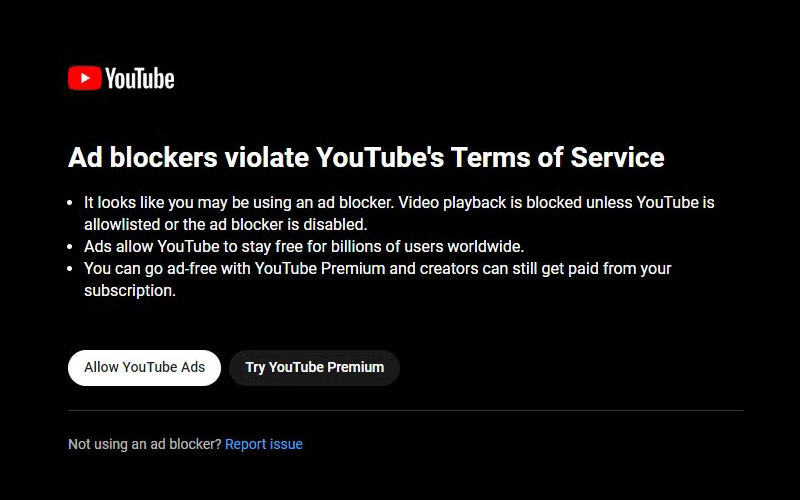On the web and apps, Google is able to follow users around whenever they're online, in order to profile them and understand their habits and interest.
As a result of this, the tech company can target them with ads that are the most relevant to them, driving increased clicks and interactions.
The thing is, not everyone likes ads, and not everyone loves Google's stalking abilities.
Because of this, many internet users rely on what's called "ad blockers," which essentially stop ad scripts from running, thus preventing ads from showing up.
Google, which earns most of its money from showing ads, doesn't like this at all.
And in a massive crackdown on ad blockers on YouTube, Google is making it clear, that people using ad blocks don't belong on YouTube.

I tall began when Google was found testing a way to block users from seeing anymore videos after viewing three videos.
In the test, people viewing videos on YouTube using an active ad blocker will be met with a message, saying that the "video player will be blocked after 3 videos."
Using the three-strikes rule, 'offenders' are given the option of disabling the ad-blocking software they use, or pay for YouTube Premium.
"It looks like you may be using an ad blocker. Video playback will be blocked unless YouTube is allowlisted or the ad blocker is disabled," the message reads.
It also states that ads “allow YouTube to stay free for billions of users worldwide," and that to stay ad free, a subscription to YouTube Premium is necessary.
When YouTube finally released the blocking mechanism to all users and starts enforcing the rules, pretty much all ad blocker users become annoyed.

At least initially, there is no way to bypass the popup, and that there is no way to prevent YouTube from blocking ad block users from seeing more videos that intended.
Google, which is putting its money where its mouth is, created what's considered an "adblockpocalypse" where popular ad blockers are seeing as many as 50,000 uninstalls in a single day.
The exodus include people uninstalling ad blockers' extensions from their web browsers.
AdGuard, one of the most popular providers of ad blocker tool, said that its daily uninstalls rose to approximately 52,000 on October 18. Previously, AdGuard’s average daily uninstalls were fractions of that, hovering at around 6,000.
Another ad-blocking company, Ghostery, said that that 90% of its users who completed a survey when uninstalling their ad blocker cited YouTube’s changes as the reason.
In the past, YouTube has long turned a blind eye toward ad blockers.
There were many people who use ad-blocking extensions, even when they violated its terms of services.
But this time, by blocking ad-blocking tools, YouTube is suggesting disappointed ad blocker users to subscribe to YouTube Premium instead, which among the perks, include the ability to view videos ad-free.
As a result of this, YouTube has become the number one public enemy among ad-blocking companies.

"For someone who wants to find extensions because they want more privacy, it may be hard," said Chrome Web Store developer lead Chary Chen.
"Now we’re introducing this new privacy and security category and it’s easy for a user to just go there and find the extension they want."
It's also worth noting that as users are uninstalling the software in record numbers, a similar but opposite effect also happens, in which higher numbers of users are turning to better ad blockers.
Hundreds of thousands of users have uninstalled ad blockers in October, seemingly in connection with YouTube’s broadened crackdown, data also shows that record-breaking numbers of people are also installing alternatives that may help them see YouTube without ads.
An increasing number of people also install and start using alternative browsers, mainly those with ad-blockers built-in, and scout for ways to bypass YouTube ads by using methods, like changing DNS, for example.
There’s been quite a few changes happening at YouTube since Neal Mohan took over from longtime CEO Susan Wojcicki.
Mohan was a big part of growing Google’s ad business, and was working closely with Wojcicki, after playing a key role in the integration process with DoubleClick, before Google rebranded it to AdSense.
